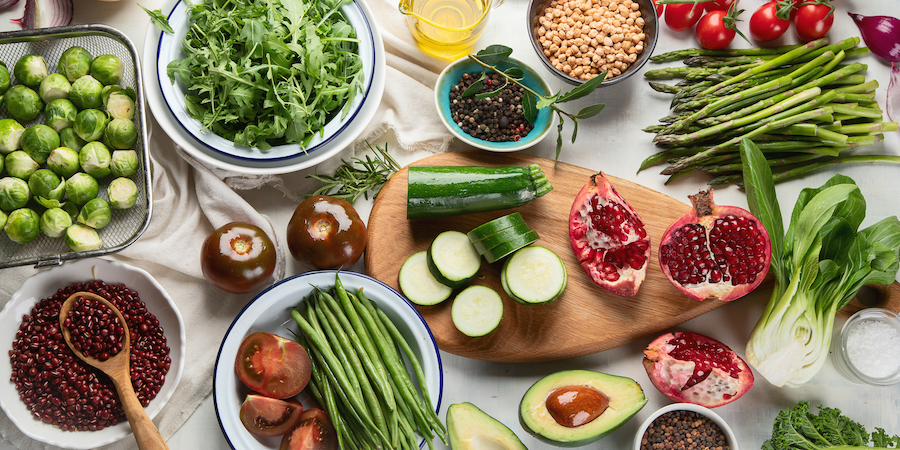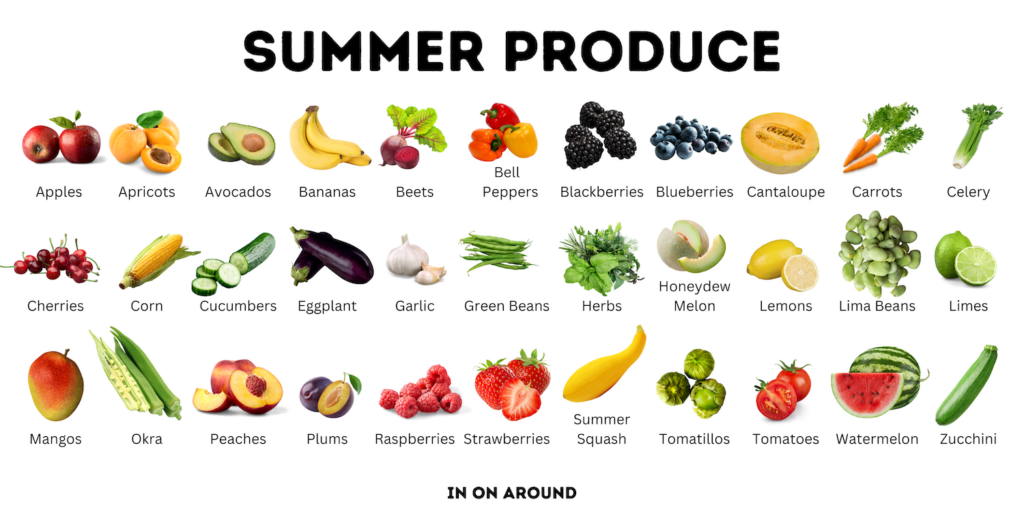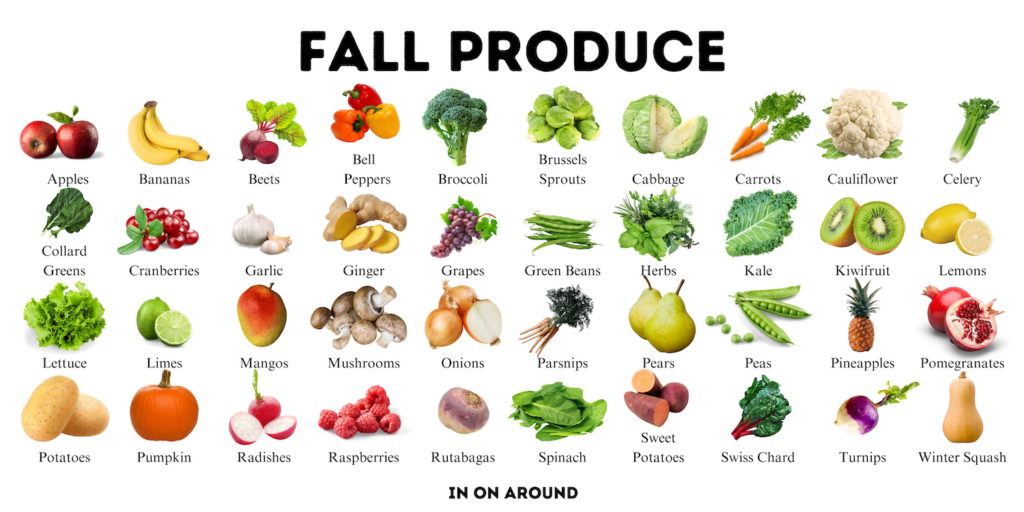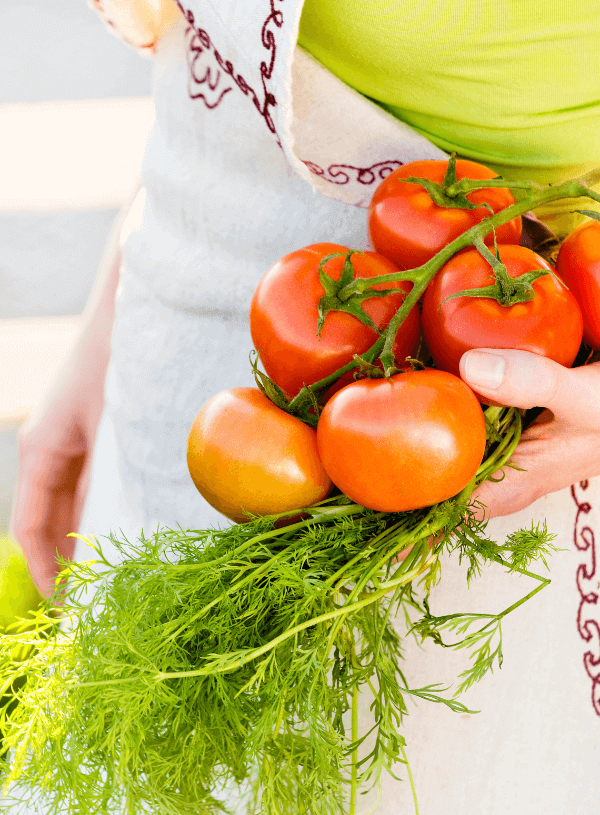We live in a world where every fruit and vegetable seems available all year round. From crisp apples in autumn to perfectly juicy berries in the summer, each season offers its unique seasonal produce. But what are the benefits of seasonal eating? What are the different growing cycles and what type of produce should you look for each month?
Keep reading to learn more about the pros and cons of eating with the seasons.

Note: This article contains affiliate links, meaning In On Around will make a small commission at no additional cost to you. This helps us maintain the site. As always, we value full transparency & only work with brands we love and trust.
Authors: Kathlyn Carney, MS, CNS and Catherine Power.
Medically reviewed by: Dr. Ana Engelhardt.
- Published On: March 28, 2024
- Updated On: April 10, 2024
Table of Contents
What Is Seasonal Eating?
Eating seasonally is exactly what it sounds like! To eat seasonally is to eat food that is harvested during that season in a particular area.
The Department for Environment Food and Rural Affairs (DEFRA) created two separate definitions of seasonal food.
- “Produced in season (global seasonality): This refers to food that is outdoor grown or produced during the natural growing/production period for the country where it is produced. It doesn’t necessarily need to be consumed locally to where it is produced.”
- “Produced and consumed in season (local seasonality): This refers to food that is produced and consumed in the same climatic zone without high-energy use for storage.”
Eating seasonal food offers a sustainable approach to food production and consumption. It promotes the reliance on locally available produce while reducing carbon emissions associated with transportation and artificial preservation methods. Essentially, it encourages individuals to enjoy foods that naturally thrive in their local environment during specific times of the year, which can foster a connection to the land and help the environment.
Let’s dive into this concept some more!
The Benefits of Seasonal Eating
Eating seasonally offers numerous benefits. Not only does it help us consume food at its freshest which maximizes its nutrient content, but it also plays a crucial role in reducing the environmental impact associated with shipping food over long distances. Our ancestors evolved to eat seasonally, suggesting that this approach may align best with our biological needs because it encourages us to eat diverse foods over the course of the year.
The FRESHER the produce = the HEALTHIER it is
Moreover, embracing seasonal eating can be advantageous for our wallets, as locally sourced produce tends to be more affordable. By choosing to eat in harmony with the seasons, we not only support our health but also contribute to a more sustainable food system.

Is Seasonal Produce Healthier?
In short, yes. Seasonal produce is healthier! According to UMMS Health, fruits and vegetables that ripen naturally and are eaten soon after harvesting contain higher levels of vitamins, minerals and antioxidants. After harvest, the nutrient density of fruits and vegetables begins to decline due to a process called respiration.
Plus, seasonal produce that are grown locally are often described as more delicious and better quality than produce that is out of season or imported. Additionally, when you consume foods that are in season, you reduce the risk of the produce being covered in preservatives or waxes that help to prolong the shelf-life.
Environmental Impact of Seasonal Eating
Embracing seasonal eating not only supports our health by providing nutrient-rich foods and minimizing preservatives, but it also contributes to environmental sustainability! By reducing the need for long-distance transportation and storage, you’re reducing your “food miles.”
Food miles = the distance it takes for your food to travel from where it’s grown to a grocery store near you.
The concept of food miles, coined by Tim Lang in the early 1990s, highlights the distance food travels from its origin to reach consumers in stores and aims to foster a deeper understanding of food sourcing. Beyond mere distance, food miles encompasses the environmental impact of transportation, including fuel consumption and associated greenhouse gas emissions (GHGE). Individuals may contribute to lowering their carbon footprint and save money in the process by embracing seasonal eating.

Economic Considerations of Seasonal Eating
If health and environmental considerations aren’t enough to convince you, buying locally grown is oftentimes more affordable! This is because of supply and demand – other local farmers are harvesting similar crops.
Additionally, since locally sourced food spends less time in transit, it tends to be fresher and may come with reduced costs related to shipping and storage. Supporting local farmers keeps money circulating within the community, bolstering the local economy and creating job opportunities for neighbors.
Overall, opting for locally grown, seasonal produce not only benefits consumers but also contributes to the vitality and sustainability of the community.
If you would like to read more about the health benefits of seasonal eating, check out this article too: Why Should We Eat Seasonally And Locally (Even In The Winter)?
Seasonal Produce Can Vary Based on Where You Live
Will seasonal produce depend on where you live in the world? Yes – here’s why:
Seasonal eating depends on geographical location due to diverse growing conditions and weather patterns. The availability of seasonal produce in your area is influenced by factors like climate, soil quality, and sunlight exposure, all of which affect crop growth and harvest times.
While certain fruits and vegetables may be in season in one region, they may not be available or may have different growing seasons in another. Purchasing local, seasonal produce allows individuals to embrace the freshest and most abundant crops while supporting regional agriculture!
Different Growing Cycles Throughout The Year
The growing seasons for fruits and vegetables vary depending on their tolerance to temperature and environmental conditions.
- Spring = “cool-season” crops
- Summer = “warm-season” crops
- End of summer or fall = plants that are harvested for storage
- Winter = “cold-season” crops
In spring, known as the season for “cool-season” crops, vegetables that germinate in colder soil and can withstand lower temperatures grow best. These include leafy greens like lettuce, spinach, and kale.
As temperatures rise in summer, “warm-season” crops are most available because they do best under hot conditions. This category encompasses popular summer staples like berries, tomatoes, peppers, and cucumbers.
Towards the end of summer and into fall, attention shifts to plants that can be stored, including winter squash and pumpkins. Understanding these seasonal patterns helps consumers decide what produce they want to purchase to make the most of each crop’s optimal growing conditions.
How Do You Find Seasonal Foods?
Finding seasonal foods can connect you with the freshest produce available. One common place to buy seasonal produce are grocery stores. Seasonal fruits and vegetables are often prominently displayed and labeled to inform shoppers of their origin and freshness at the grocery store.
Another option is going to local farmer’s markets, where farmers directly sell their seasonal bounty and offer their freshly harvested goods.
Community Supported Agriculture (CSA) programs are another way to access seasonal foods by allowing consumers to subscribe to a share of a local farm’s harvest. Typically, they sign up for a CSA for one season and receive regular deliveries or pickups of freshly harvested produce for a few months.
Starting A Garden? Tips For Growing Your Own Food
Starting an at-home garden is one of the best ways to eat seasonally and locally! If you have only a small space for an outdoor garden, start here:
Plants for small spaces:
- Carrots
- Herbs
- Tomatoes / Cherry Tomatoes
- Peppers
- Cucumbers
- Eggplant
- Lettuce
- Radishes
- Peas
- Microgreens
- Strawberries
- Squash
- Zucchini
Plants to grow together (Companion Planting):
Companion planting is a gardening practice where specific plants are grown near each other to achieve beneficial outcomes such as pest control, plant and soil health, and more. These plants work well together:
- Asparagus and tomatoes
- Basil and peppers
- Beans and corn
- Beets and garlic
- Broccoli and cabbage
- Cabbage and sage
- Carrots and peas
- Corn and squash
- Cucumbers and radish
- Lettuce and scallion
- Onions and strawberries
- Peas and spinach
- Peppers and oregano
- Potatoes and cilantro
- Radish and lettuce
- Pumpkin and buckwheat
- Spinach and rosemary
- Tomatoes and parsley
- Zucchini and oregano
How to Join a CSA for Seasonal Produce
If you are interested in finding a CSA near you, Local Harvest has a search bar on their website that will easily connect you to local farms that offer CSAs. Click here to find a CSA in your area! This is a great way to support local farmers.
You can also search “CSAs near me” to see what search options are available in your area. Or ask around at your local natural foods store – someone may offer a recommendation!

Foods To Buy Each Season
This is your quick reference while grocery shopping! Save this article for future reference.
Note: this is produce that’s available in the United States during different months of the year. If you’re outside of the US, this information may be different for your specific area and season. These lists are not exhaustive and they may change.
The Seasonal Food Guide here is a great reference by month and state. The below information is from the USDA.
Year-Round Produce
- Apples
- Bananas
- Banana squash
- Carrots
- Cauliflower
- Celery
- Coconuts
- Cultivated mushrooms
- Eggplant
- Garlic
- Ginger
- Golden pineapple
- Green onions
- Herbs
- Lettuce
- Lemons
- Lime
- Potatoes
- Snow peas
- Sprouts
- Sweet peppers
- Tomatoes
Winter Seasonal Produce

| Apples | Limes |
| Avocados | Onions |
| Bananas | Oranges |
| Beets | Parsnips |
| Brussels Sprouts | Pears |
| Cabbage | Pineapples |
| Carrots | Pomegranates |
| Celery | Potatoes |
| Collard Greens | Pumpkin |
| Grapefruit | Rutabagas |
| Herbs | Sweet Potatoes & Yams |
| Kale | Swiss Chard |
| Kiwifruit | Turnips |
| Leeks | Winter Squash |
| Lemons |
Spring Seasonal Produce

Apples | Lemons |
Apricots | Lettuce |
Asparagus | Limes |
Avocados | Mushrooms |
Bananas | Onions |
Broccoli | Peas |
Cabbage | Pineapples |
Carrots | Radishes |
Celery | Rhubarb |
Collard Greens | Spinach |
Garlic | Strawberries |
Herbs | Swiss Chard |
Kale | Turnips |
Kiwifruit |
|
Summer Seasonal Produce

Apples | Herbs |
Apricots | Honeydew Melon |
Avocados | Lemons |
Bananas | Lima Beans |
Beets | Limes |
Bell Peppers | Mangos |
Blackberries | Okra |
Blueberries | Peaches |
Cantaloupe | Plums |
Carrots | Raspberries |
Celery | Strawberries |
Cherries | Summer Squash |
Corn | Tomatillos |
Cucumbers | Tomatoes |
Eggplant | Watermelon |
Garlic | Zucchini |
Green Beans |
|
Fall Seasonal Produce

Apples | Lettuce |
Bananas | Limes |
Beets | Mangos |
Bell Peppers | Mushrooms |
Broccoli | Onions |
Brussels Sprouts | Parsnips |
Cabbage | Pears |
Carrots | Peas |
Cauliflower | Pineapples |
Celery | Pomegranates |
Collard Greens | Potatoes |
Cranberries | Pumpkin |
Garlic | Radishes |
Ginger | Raspberries |
Grapes | Rutabagas |
Green Beans | Spinach |
Herbs | Sweet Potatoes & Yams |
Kale | Swiss Chard |
Kiwifruit | Turnips |
Lemons | Winter Squash |
Final Thoughts: Seasonal Eating Guide
By eating seasonally, we are not only nourishing our bodies with the freshest available produce that’s more flavorful, but we’re also supporting local farmers and reducing our environmental impact. It’s a win, win, win! Save this article for easy reference the next time you’re grocery shopping. Cheers to fresh produce!
Do You Eat Seasonally?
Let me know your thoughts and key takeaways in the comments below!
xoxo,

Want to read more? Check out our other articles here!
Other references on Seasonal Eating Guide from: USDA, Healthline, Proceedings of the Nutrition Society, The Benefits of Seasonal Eating – UMMS Health, Dr. Axe, The Farmer’s Almanac, BHG, Martha Stewart, Nature’s Path, US Foods, All Recipes, Simply Recipes, The Old Farmer’s Almanac
Copyright In On Around LLC 2024 ©. The statements made on this website have not been evaluated by the FDA (U.S. Food & Drug Administration). They are not intended to diagnose, treat, cure, or prevent any disease. The information provided by this website should not be used as individual medical advice and you should always consult your doctor for individual recommendations and treatment. The information contained in this site is provided on an “as is” basis. Related to this site, there are no guarantees of completeness, accuracy, usefulness, or timeliness. In On Around LLC assumes no responsibility or liability for any errors or omissions in the content of this site.
Frequently Asked Questions – How To Eat Seasonally
Click on the below FAQs to learn more about month-to-month seasonal eating guides.
Seasonal eating promotes consumption of fresher, nutrient-rich produce at its peak, which is great for overall health and well-being.
You can find seasonal produce near you by visiting local farmers’ markets, joining community-supported agriculture (CSA) programs, or by referring to online resources for nearby farms in your area.
Yes, seasonal eating can be more affordable than out-of-season produce due to higher supply and less transportation costs.
Yes, seasonal eating is very environmentally friendly since it requires less storage, gas, and oil for transport.








